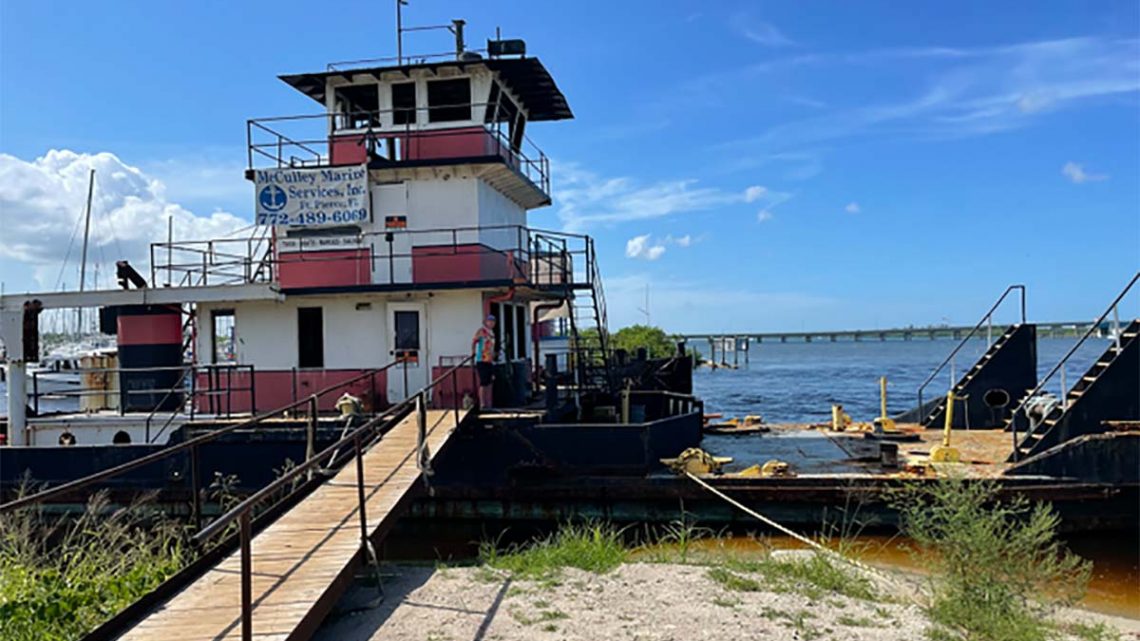
Giving back: Tugboat sinking for Oculina coral artificial reef honors Blake Charron
Treasure Coast Newspapers, 09/24 /2021. By Ed Killer
A decommissioned tugboat (was) sunk as an artificial reef Saturday, about 13 miles southeast of the Fort
Pierce Inlet and 13 miles northeast of the St. Lucie Inlet.
Tug Singleton — 85 feet long, 30 feet wide and 42 feet tall — (is) the 68th artificial reef St. Lucie County has deployed since 2005, said Coastal Resources Director Jim Oppenborn. The steel tug, built in 1951, (is) the fifth
tug sunk since 1995.
If weather and sea conditions permit, McCulley Marine Services will begin the approximately three-hour tow out to sea at 6 a.m. Sept. 25, leaving through the Fort Pierce Inlet. If the weather is bad, the sinking will be rescheduled for Oct. 2.
Tug Singleton will be sunk in the Fort Pierce Sportfishing Club area Tug Singleton will be scuttled in 164 feet of water in the Fort Pierce Sportfishing Club‘s permitted artificial reef deployment area, at the southern end of a natural Oculina coral reef stretching from St. Augustine to St. Lucie County.
The tug will have 32 concrete reef modules attached to it, to add more growing-surface structure for corals as Oculina varicosa, also known as ivory tree coral. The water there is too deep for recreational divers, but the tug is expected to provide good habitat for reef-dwelling species of fish such as grunt, grouper, snapper, trigger fish and sea bass, Oppenborn told TCPalm.
Blake Charron Foundation chips in
Florida native Blake Charron was an avid diver, angler, boater and a loving son, brother, father and friend to many, according to the Blake Charron Foundation website. His family created the foundation to support causes he believed in to support “environmental and social impact projects to conserve, protect, restore and enhance marine and coastal habitats and communities throughout Florida and the Caribbean, giving back to the locations that gave so much to Blake and his family.”
The Madeira Beach resident was 31 when he lost his struggle with addiction in December 2019. The foundation’s involvement in this artificial reef fits its mission. “As an avid fisherman and diver, Blake was acutely aware of the impact that pollution and coral reef decimation had on those activities which he loved,” reads the foundation’s page. “He realized the need to res
Who paid for artificial reef program?
The foundation helped pay some of the costs of the acquisition, preparation and sinking. The tug was acquired from a Brevard County boatyard earlier this year for $30,000 — about what it would have earned as scrap metal, Oppenborn said.
Funding also came from St. Lucie County and a Florida Fish and Wildlife Conservation Commission grant. The grant comes from the federal Sportfish Restoration Foundation, funded by purchases of fishing equipment and motorboat fuels, and the Florida Marine Resource Conservation Trust Fund, funded by purchases of FWC saltwater fishing licenses.
“Both funding sources have been designated as a user pay, user benefit program,” Christine Kittle, a fisheries biologist with FWC’s Artificial Reef Program, told TCPalm in an email. “So fishers and divers contributed to this reef.”
